Shakespeare in Love
There are very, very few movies out there of which I would say that I’d like to reproduce almost *all* costumes from. Shakespeare in Love is one of them.
All the costumes in this movie are *mostly* historical – *mostly*, because they include a vast mix over almost 50 years of Elizabethan fashion. This is quite funny as the time in which the movie plays doesn’t take longer than approximately two to three months.
It’s also funny to see someone (upper class, mind you, so she should wear something considered fashionable in court!) wear clothing from c. 1560-70 and the Queen – being present in the same room – wears clothing that clearly dates *after* 1590 (so to be seen right at the beginning of the movie, with Viola’s „Blue comedy gown“ and the Queen’s „Comedy“ gown). And I won’t even comment on the vast mix of time- and also country wise fashions in that scene (look at the first image below; there are two spanish women sitting in front of Viola (one of them being blonde…)!).
Well, anyway. The costumes are nice (even if just very, very few of them seem to be absolutely historically correct), so I love the movie quite a lot.
Here are the screenshots of the costumes from that movie and the DVD specials, sorted costume wise but not necessarily in the order in which they appear in the movie. I’ve also briefly commented the historical correctness of each gown:
Blue „Comedy“ gown:
From the narrow sleeves, the relatively small neck ruff and shoulder wings, tight fitting partlet and the fact that this gown is worn with the spanish farthingale, I would date the shape of this gown to c. 1560-70.
The decoration of a ’stomacher‘ is not really historically correct but dates to the next époque of rococo.
Peacock gown:
The high standing collars, large hanging sleeves, puffed undersleeves and very straight bodice date the shape of this gown to c. 1590-1600 (the Queen would have been between 57 and 67 by then).
However, the small neck ruff doesn’t fit – it wouldn’t have been worn by that time. Plus by that time the wheel shaped french farthingale was in fashion and one would have to wonder why Elizabeth would wear the old, A-shaped spanish farthingale with the gown.
There would also be the possibility to date this gown to c. 1585-90, to the time of the „Armada“ portrait:
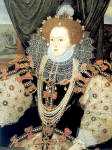
but by that time, the large neck ruff had not yet become split (i. e., developed into a standing collar), so this dating is also a little off.
The material and decoration of this gown is almost unbelievable and should almost be settled in the time around 1575, when the decoration of Elizabethan costume reached its climax.
Orange Ball gown:
From the capped sleeves, narrow sleeves and A-shaped farthingale I would date this gown to c. 1570-75. The decorations seem quite period, too; so this is a very pleasant, historical gown to look at.
The Queen’s „Theatre“ gown:
Same problem as with the „Peacock“ gown:
From hanging- and undersleeves, standing collar and straight bodice, this gown would have to be dated to c. 1590-1600 (the Queen would have been between 57 and 67 by then).
This time she doesn’t wear the small neck ruff, but a period looking jewel. But still – by that time the wheel shaped french farthingale was in fashion, and one would have to wonder why Elizabeth would wear the old, A-shaped spanish farthingale with the gown.
The pattern of the pintucked sleeve fabric is absolutely historical. Something likely is visible in this portrait of Queen Elizabeth I.:
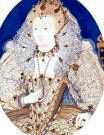
which dates to around 1595-1600.
Viola’s male disguise:
Viola’s wedding dress:
From the high necked doublet (which is a little *too* high necked…), the moderate undersleeves and the not quite floor length oversleeves as well as the spanish, A-shaped farthingale I would date this gown to c. 1585. What I’m completely missing, however, is any kind of neck ruff – *or* I would have to assume that this gown’s doublet was made / worn after an Italian fashion from around 1550-60…
Viola’s nightgowns, undergarments and morning dresses:
Nothing to object; smock, farthingale and stays look very good in my humble opinion.
Viola’s riding habit (with and without the green riding coat):
Bodice:
moderate sleeve rolls – narrow sleeves – small partlet – around 1570-75.
Green coat:
Doublet after Italian fashion from around 1550-60 (with open, standing collar), moderately puffed sleeves and A-shaped skirt – date / place the rest of this gown to England, around 1575.
Viola’s red „Prayer“ dress:
The bodice and the skirt, which is obviously just worn with a bumroll, are so perfect that I think it’s the best historic costume in the movie – with two exceptions; but first, the good things:
– The neckline of the ’smock‘ (that’s, in my opinion, what’s visible inside the neckline of the red bodice) is decorated with very beautiful polychrome embroidery, just like the front split bodice itself. What I can’t figure out is why that smock is – obviously! – also front split; at least it looks like that in the movie.
The bodice, the tabbing, the shape of the skirt – perfect for c. 1560.
Now the not so good things:
Though it’s just *very* briefly visible in the movie, the skirt seems to be printed – cream ground with a red pattern. Printing fabrics, however, was not known back then. So I would have to assume that this is red work – embroidery with red threads, as weaving such tiny patterns was also not common practice. However, I think that red work would, well, I think it would drape differently as the threads should stiffen the fabric.
And… the sleeve heads, which consist of slashed stripes. I know that something likely exists in portraits, such as these:
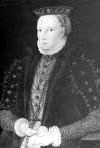

but as you will probably notice the slashed upper sleeves all end over the elbow, and I don’t think I’ve seen one portrait with a *complete* sleeve.
Queen Elizabeth’s „Comedy“ gown:
*SO* beautiful – and a perfect example of late Elizabethan clothing (almost).
The wheel- or drum shaped farthingale with the pinned skirt, the hanging sleeves and standing collar date to c. 1590-95.
However… and here’s the only thing I have to object… same as with the „Peacock“ gown: The neck ruff doesn’t fit – as in: Not at all.
But the billiment decorations (pearl embroideries) are just beautiful. It seems to me as if this gown was a combination of several gowns from portraits; namely:
 |
 |
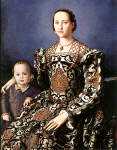 |
| „Ditchley“ Portrait Marcus Gheeraerts the Younger, c. 1592 |
Elizabeth I. unknown Artist from the English School, 1592 |
Eleonora di Toledo & son Agnolo Bronzino,1550 |
| The loose outer shape, hanging / puffed sleeves seem to come from this portrait… | …the coloring scheme seems to have been developed from this gown’s forepart (though this forepart seems to be stained, not woven)… | …and the pattern of the fabric seems to be likely to this here, even if „this here“ is cut velvet and that above is brocade or damask, plus, the colors don’t match. |
Viola’s yellow „Audience“ gown:
What have we here… narrow under sleeves, curved and slashed over sleeves, bodice with large skirtings and the standing collar combined with an A-shaped spanish farthingale.
The undersleeves date from c. 1550-60.
The open oversleeves, which are spanish, as well as the skirtings, which don’t extend to the front middle of the bodice (as they should) should date to c. 1580.
The standing collar was worn from c. 1590 on.
The A-shaped farthingale was worn until c. 1590.
In short terms – that particular gown is probably the most mixed up in the movie.
Other costumes – e.g. Shakespeare’s, Viola’s „Juliet“ costume etc.:
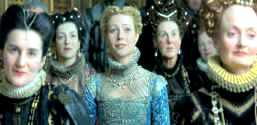
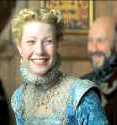

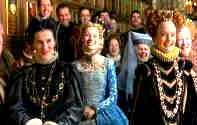




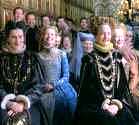
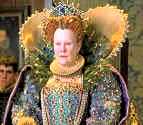
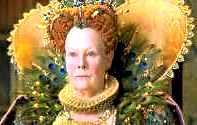
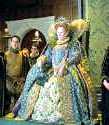



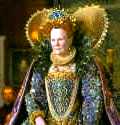
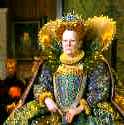
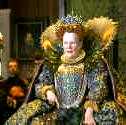
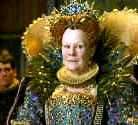
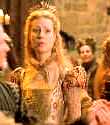
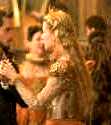
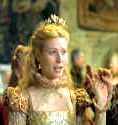



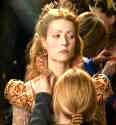






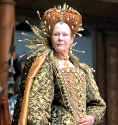
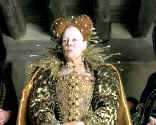
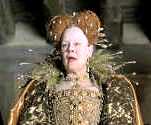
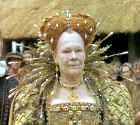


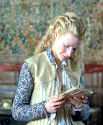
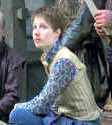
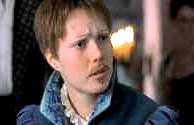
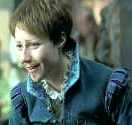

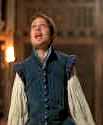


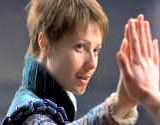


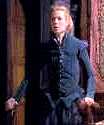
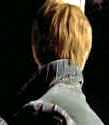
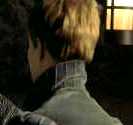

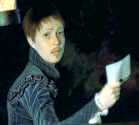
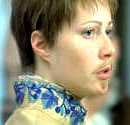

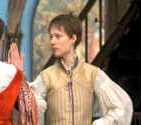
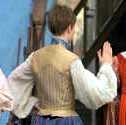
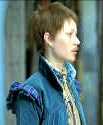
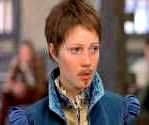
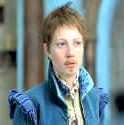
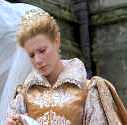
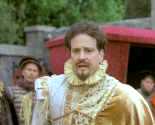

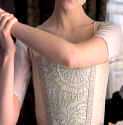
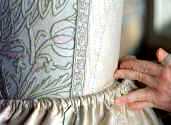
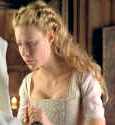



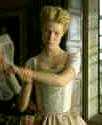
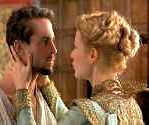

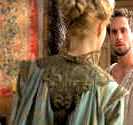
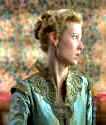
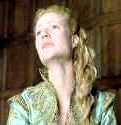
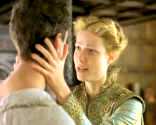
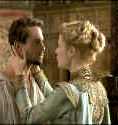
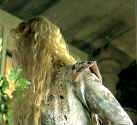
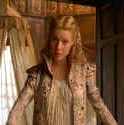
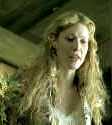
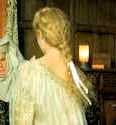

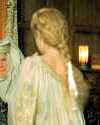
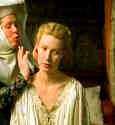
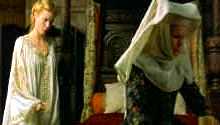
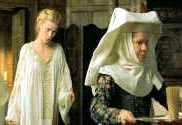
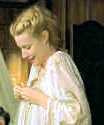
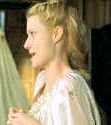
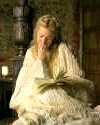
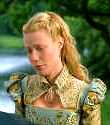
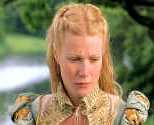


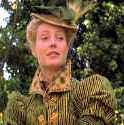



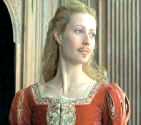
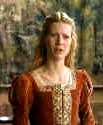


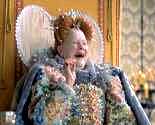
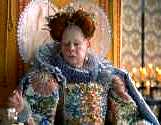
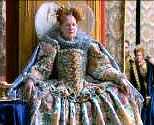
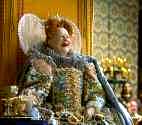
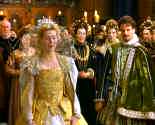



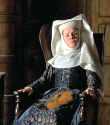
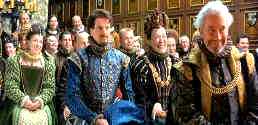

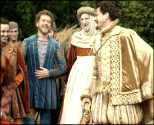
Um, there are in fact people in Spain with blonde colored hair. Most if not all European countries and their citizens are quite diverse with physical appearance. Has been for centuries.
Oh, I wasn’t doubting that there are Spanish women with blonde hair. By the way, I’m from Germany; so I’m quite aware of varying physical appearances of Europeans 😉
I merely pointed the Spanish woman with her hair color out because, you know, some people wouldn’t recognize a blonde Spanish woman because they would think that they would have to look for a dark haired woman.